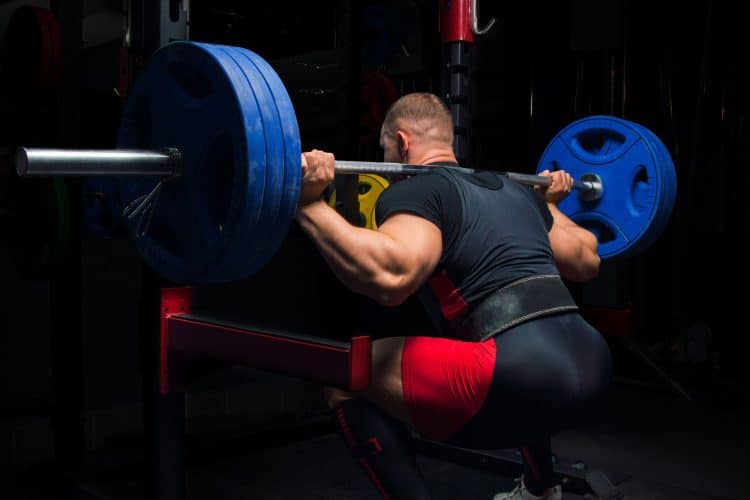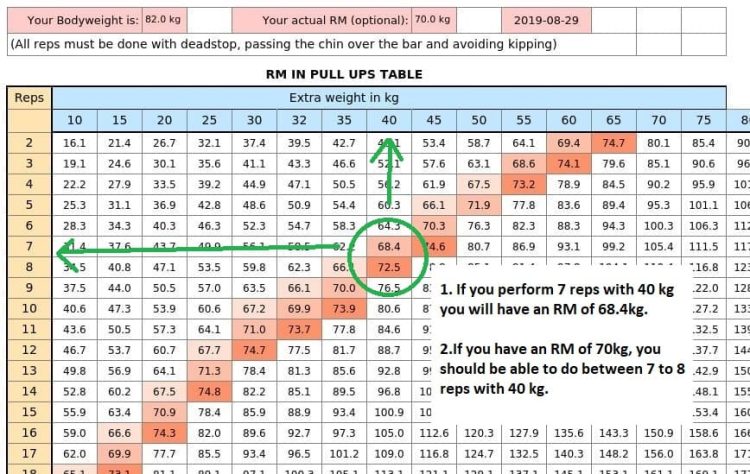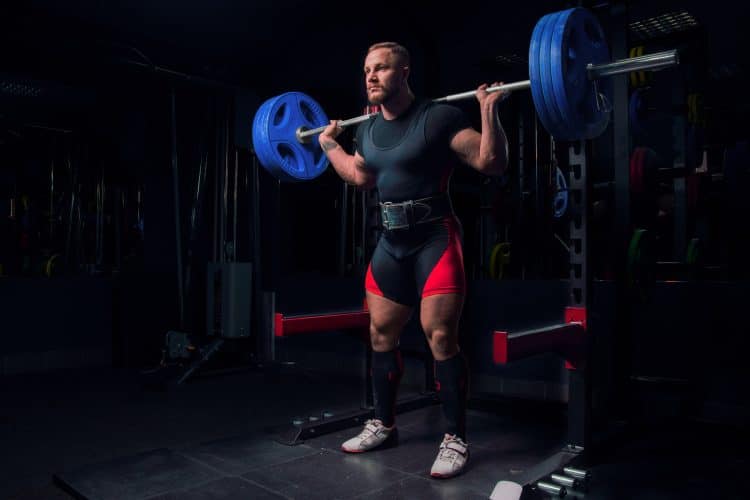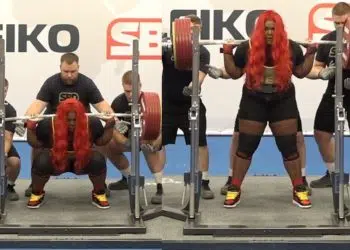Squats are the crowned king of exercises. Whether you are a bodybuilder, powerlifter, strongman, gym bro, or booty girl, the squat should be part of your workouts. They’re even good for fat loss!
But what is your squat one rep max, and how much weight should you use for your squat workouts?
Use this calculator to estimate your back squat one-repetition maximum or see how many reps you should be able to do with a given weight.
Squat Max Calculator
Unit weight type:
Option 1: Specific result
Calculator Mode :
Input your RM :
Added weight :
Number of Repetitions :
What Is the One Rep Max Back Squat Calculator?
Your one-repetition maximum, known as your one-rep max or 1RM for short, is the weight you can lift once but not twice. Your 1RM reveals how strong you are for a particular lift or exercise.

Our back squat one rep max calculator is designed to estimate your 1RM for the squat from the weight you can lift for a certain number of reps. In addition, you can also use it to determine how many back squats you should be able to do with a specific weight.
These numbers can be helpful for assessing your current level of strength, measuring your progress, and planning your next training cycle.
Level Up Your Fitness: Join our 💪 strong community in Fitness Volt Newsletter. Get daily inspiration, expert-backed workouts, nutrition tips, the latest in strength sports, and the support you need to reach your goals. Subscribe for free!
While there is nothing wrong with testing your one rep max by loading a barbell with lots of weight and attempting to squat it, this can be both dangerous and extremely tiring. You’ll also need a squat or power rack and a couple of strong spotters. Real 1RM testing is best left to experienced exercisers and should not be attempted by beginners.
Our squat 1RM calculator requires less exertion, is 100% safe, and is suitable for beginner, intermediate, and advanced lifters. On the downside, it IS a prediction of your 1RM and is not 100% accurate. Still, it’s good enough for all but the most exacting powerlifter.
So, whether you are a bodybuilder, powerlifter, or strongman competitor, this 1RM back squat calculator will be very handy!
How to Use the One Rep Max Back Squat Calculator
Our one-rep max squat calculator is straightforward to use. Just follow these steps:
Option 1: Compute a Specific Result
1- Calculator Mode: Reps to RM
- Select your units – kilograms or pounds.
- Input the weight lifted.
- Input the number of reps you performed.
- Read off your estimated squat 1RM.
2- Calculator Mode: RM to Reps for Specific Weight
- Select your units – kilograms or pounds.
- Enter your current 1-RM.
- Enter the weight you want to use (training weight).
- Read off the number of squats you should be able to do with your training weight.
3- Calculator Mode: RM to Weight for Specific Reps
Select your units – kilograms or pounds.
- Enter your 1-RM.
- Enter the number of squats you want to do.
- Read off the weight you should be able to lift for the specified number of reps.
Option 2: Calculate the 1RM Table
Option two produces a table of your squat 1RM and various percentages and rep maxes based on that result. Print it out and carry it with you so you can quickly determine how much weight to use or how many reps you should do during your squat workouts.
- Select your units – kilograms or pounds
- Enter your 1-RM for the squat
- View the table (see example below).

How to Improve Squat One Rep Max
If you care about your back squat one rep max, you probably want to improve it. After all, yesterday’s one rep max is old news! So, here are the training methods and strategies you need to use to put more weight on the bar and set a new squat 1RM record.
1. Squat like a boss
If you want to squat big weights, you need to be a squat master. In other words, your technique needs to be as close to perfect as possible. Poor technique is inefficient, wastes energy, and can take pounds off your one rep max. It can even lead to injuries.
So, don’t just train the squat, but practice it, too. And remember, ugly squats are invariably weak squats. Time spent fixing your squat can add a lot of weight to your 1RM.
2. Squat twice a week
A lot of lifters only squat once a week. This may be a mistake. Squatting only once per week means you don’t get much time to practice and perfect your technique. Also, a growing body of research suggests that muscles respond best to more frequent workouts (1).
So, squat twice a week to increase your one rep max. Do one heavy workout per week and one that’s a little lighter, where you focus more on power and speed.
These two different workouts should combine to take your squat performance to the next level.
3. Eat yourself to a bigger squat
If you want to squat big, you need to eat big! The food you eat will give you the energy you need to power through your workouts and the nutrients you need to recover and grow afterwards.

While it’s beyond the scope of this article to tell you exactly how to eat to improve your squat, here are a few tips to get you started:
- Adopt a slight calorie surplus to fuel your workouts, muscle growth, and recovery.
- Consume around one gram of protein per pound of body weight.
- Consume healthy fats.
- Drink lots of water.
- Eat plenty of complex carbohydrates.
- Minimize your intake of junk food, soda, refined foods, takeouts, etc.
Also, consider adding some carefully selected supplements to your diet. For example:
- BCAAs and EAAs – for recovery and muscle growth
- Creatine – for energy and muscle building
- Pre-workouts – for fast-acting energy and better workouts
- Protein powder – for recovery and muscle growth
- ZMA – for better sleep and hormone optimization
Read more about eating for strength and muscle gain here.
Level Up Your Fitness: Join our 💪 strong community in Fitness Volt Newsletter. Get daily inspiration, expert-backed workouts, nutrition tips, the latest in strength sports, and the support you need to reach your goals. Subscribe for free!
4. Eliminate any weak links
A chain is only as strong as its weakest link. During squats, certain muscles could be weaker than others and will limit how much weight you can lift. For example, if your lower back tends to round, you may need to work on your core strength. Alternatively, if your knees cave in, your gluteus minimus and medius need work.
Powerlifters use accessory exercises to shore up these weak links. These are exercises that will indirectly improve your squat performance.
Learn more about accessory exercises and how to program them into your workouts here.
5. Wear knee sleeves, a weightlifting belt, and lifting shoes
There are a few things you can use that can add pounds to your squat 1RM. None of these items will make up for a poor diet or improper squat technique, but it could be the difference between hitting a new one rep max or failing.
- Knee sleeves provide joint support and give you a small but welcome boost out of the bottom of your squat.
- A weightlifting belt helps you generate more intra-abdominal pressure so you can support your lumber spine more strongly.
- Weightlifting shoes raise your heels slightly to keep your torso a little more upright and maximize muscle engagement.
While you don’t have to use any of these aids, when used correctly, they could add quite a lot to your squat one rep max.

6. Try a squat peaking program
Peaking programs are used by powerlifters as they prep for their next meet. You can also use a peaking program to train for a new squat one rep max. Most start out pretty easy, but as the weeks pass, the weights get heavier, and the reps get lower to get you ready for your attempt at a new 1RM.
There are plenty of peaking plans to try, but the Smolov squat program is considered to be one of the best but it’s also one of the hardest.
FAQ
1. How often should I retest my squat one rep max?
One of the best things about our squat 1RM calculator is that you can use it to retest your squat max whenever you want. Just input your current squat weight, and the number of reps performed to determine your new 1RM. So, in theory, you can retest your squat 1RM whenever you work out.
This is a stark contrast to doing a “real” 1RM squat test. Repetition maximum testing is so strenuous that you should only do it once every couple of months, and beginners should probably avoid it altogether.
2. How many reps should I do to estimate my 1RM?
All one-rep max calculators use equations to estimate your 1RM. While most allow you to input ten or more reps, you’ll get the most accurate results if you stick to the 3-5 rep range. The lower your rep count, the less of an estimate your 1RM result will be.
3. Does this calculator work for front and back squats?
While this calculator is designed for back squats, there is no reason not to use it to estimate your front squat 1RM. However, if you do both squat variations, you should test them separately, as most people can back squat more than they can front squat.
4. Why do I need to know my squat 1RM?
There are a couple of situations where knowing your squat one rep max may be helpful:
- Program planning – many workouts involve training with a specific percentage of your 1RM, e.g., 75%. While you could estimate this weight, your workout will be more effective if you have a more accurate idea of your 1RM.
- Tracking your progress – when training for strength, it can be hard to tell if you are making progress. Testing and then retesting your squat 1RM every few weeks will reveal if your program is effective or whether you need to make changes.
- You’re a competitive powerlifter – powerlifters live and die by their squat, bench press, and deadlift 1RMs. Entire training cycles and competition peaking programs are based on current 1RMs for the big three lifts. Using a calculator makes it easier to plan your next workout cycle.
- Just for fun – why not challenge your training buddies to an informal squat-off? Use our calculator to compare results without doing a real one-rep squat test.
5. How much should I be able to back squat?
How much can you squat? Twice your body weight? That’s pretty good! However, top powerlifters can hit four, five, or even six times their body weight in competition.
While you probably won’t be challenging any world records anytime soon, there are standards that lifters can train toward. These standards are determined by your age, weight, gender, and experience. For many, a double bodyweight squat is a good target.
Check out this article and find out how your squat 1RM measures up.
6. Aren’t squats bad for your knees?
It was once thought that squats were bad for your knees, especially if you descended below parallel. However, research now suggests that squats (performed correctly, of course!) are actually good for your knees and can help ward off many of the issues that cause knee pain (2). However, you should speak to a medical professional if you have existing knee problems.
7. Heavy squats hurt my neck. What should I do?
If squats hurt your neck, you are probably resting the bar too high on your back. Ideally, the bar should sit on your trapezius, which is the meaty muscle at the top of your back. That way, the bar will be below the most prominent bone in your upper back/neck (C7).
Powerlifters often hold the bar lower than this, roughly shoulder level. This is called a low bar squat. If you’ve got good shoulder mobility, this can be a very comfortable position, as the bar has plenty of muscle to rest on.
If you are lightly muscled, you may also benefit from using a squat pad, which is a foam tube that wraps around the barbell.
Related Calculators:
Wrapping Up
Knowing your squat one rep max can help determine what weights to use for your workouts. And while there is nothing wrong with doing an actual 1RM squat test, it’s usually more convenient, and not to mention safer, to use a calculator.
Using our one-rep max squat calculator, you can not only estimate your squat 1RM but also work out how many reps you should be able to do with a specific weight.
Use this calculator every few weeks to retest your squat 1RM to see how your strength gains are progressing.
References:
1– PubMed: Effect of different training frequencies on maximal strength performance and muscle hypertrophy in trained individuals-a within-subject design https://pubmed.ncbi.nlm.nih.gov/36228016/
2– Clinical Trials.gov: Investigation of the Effectiveness of a Structured Squat-based Program in Knee Osteoarthritis Rehabilitation https://clinicaltrials.gov/ct2/show/NCT04588558











